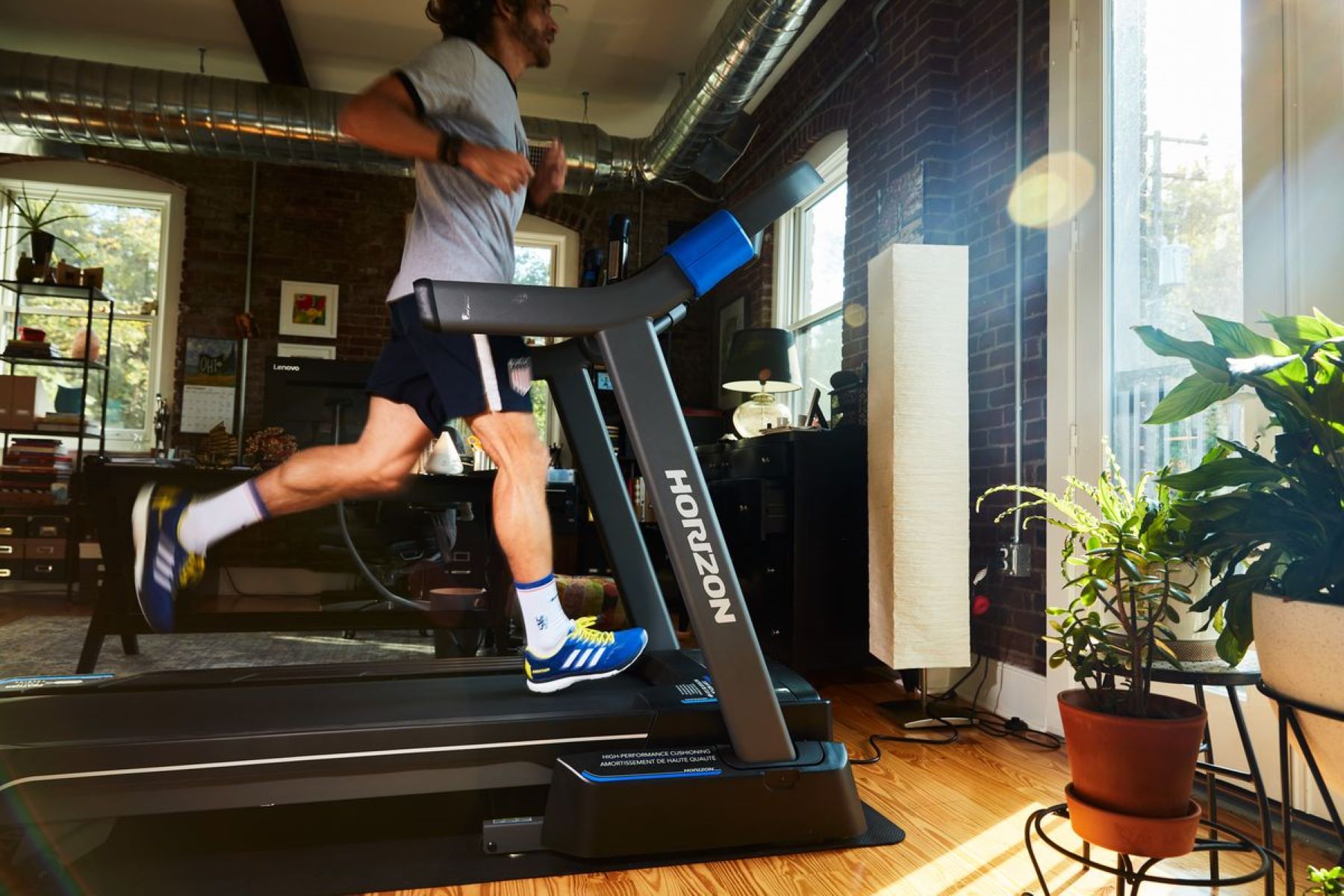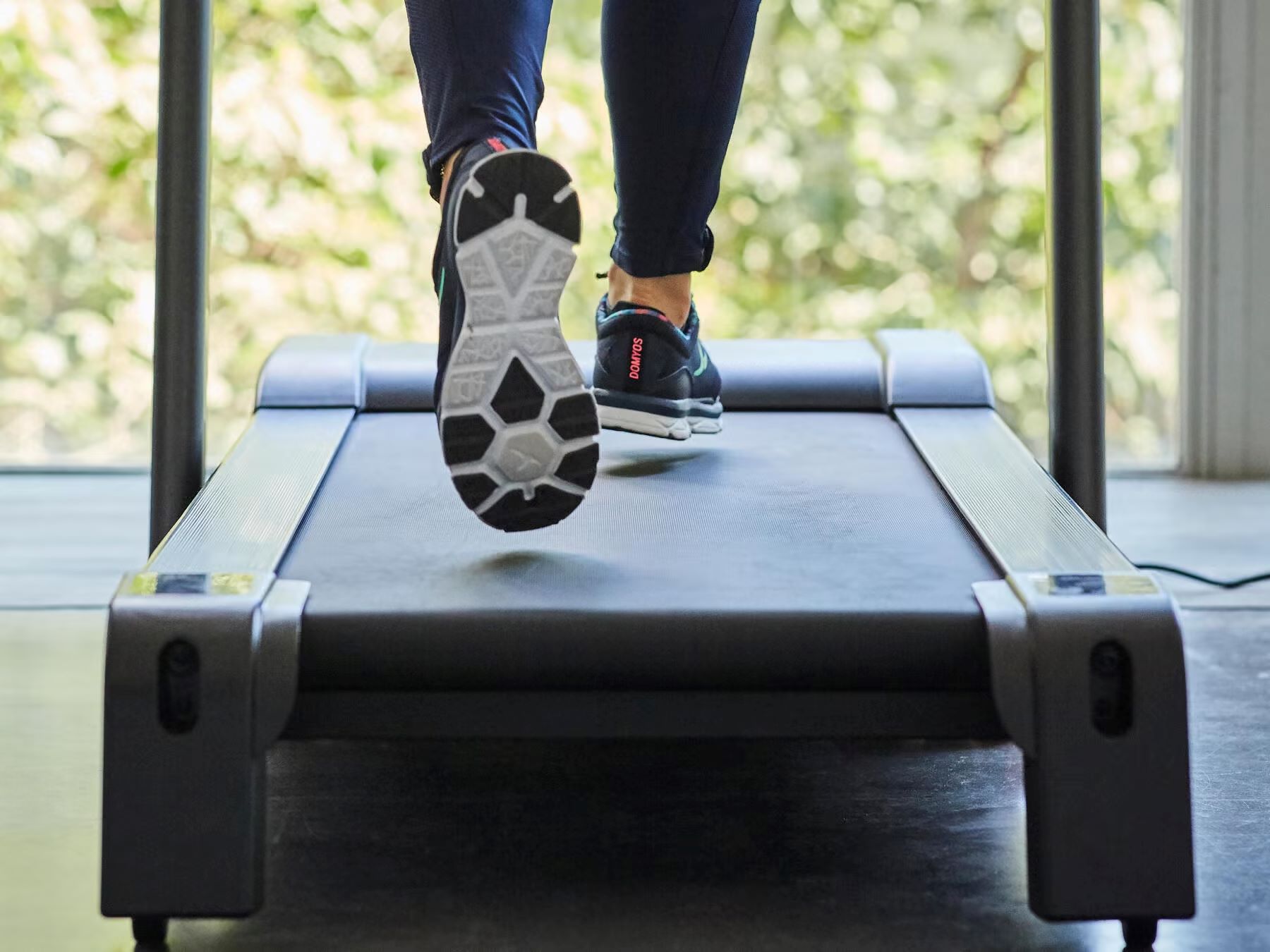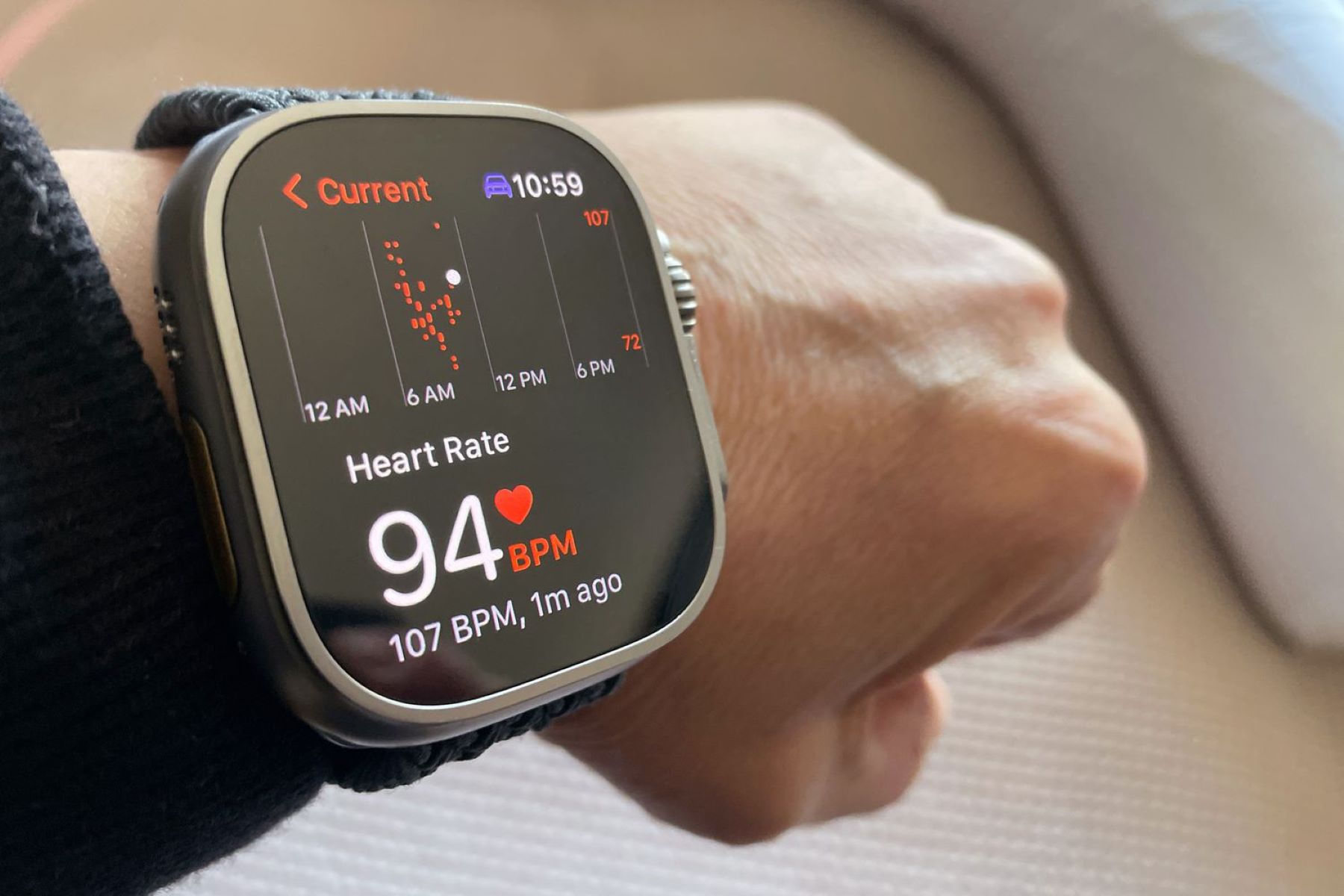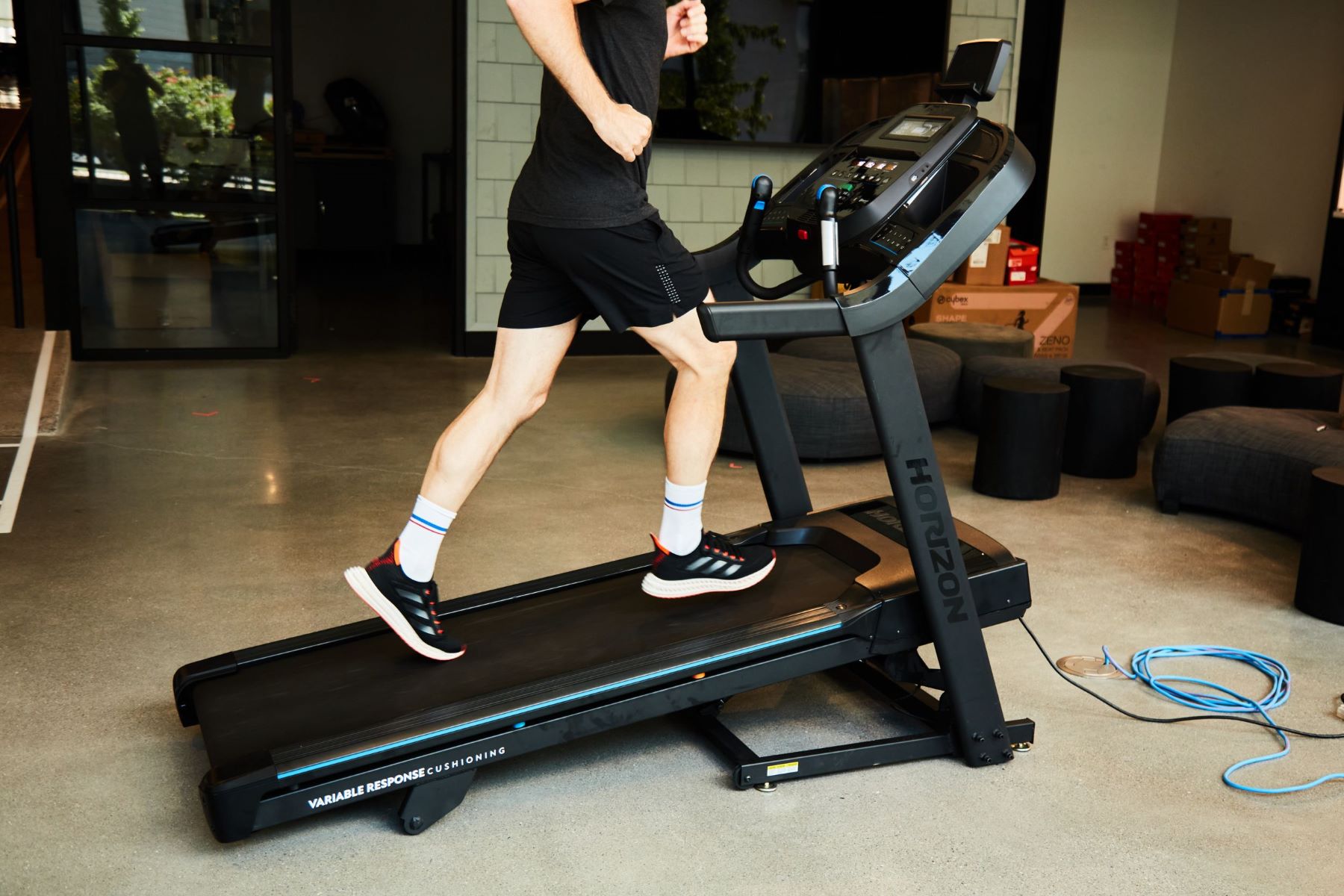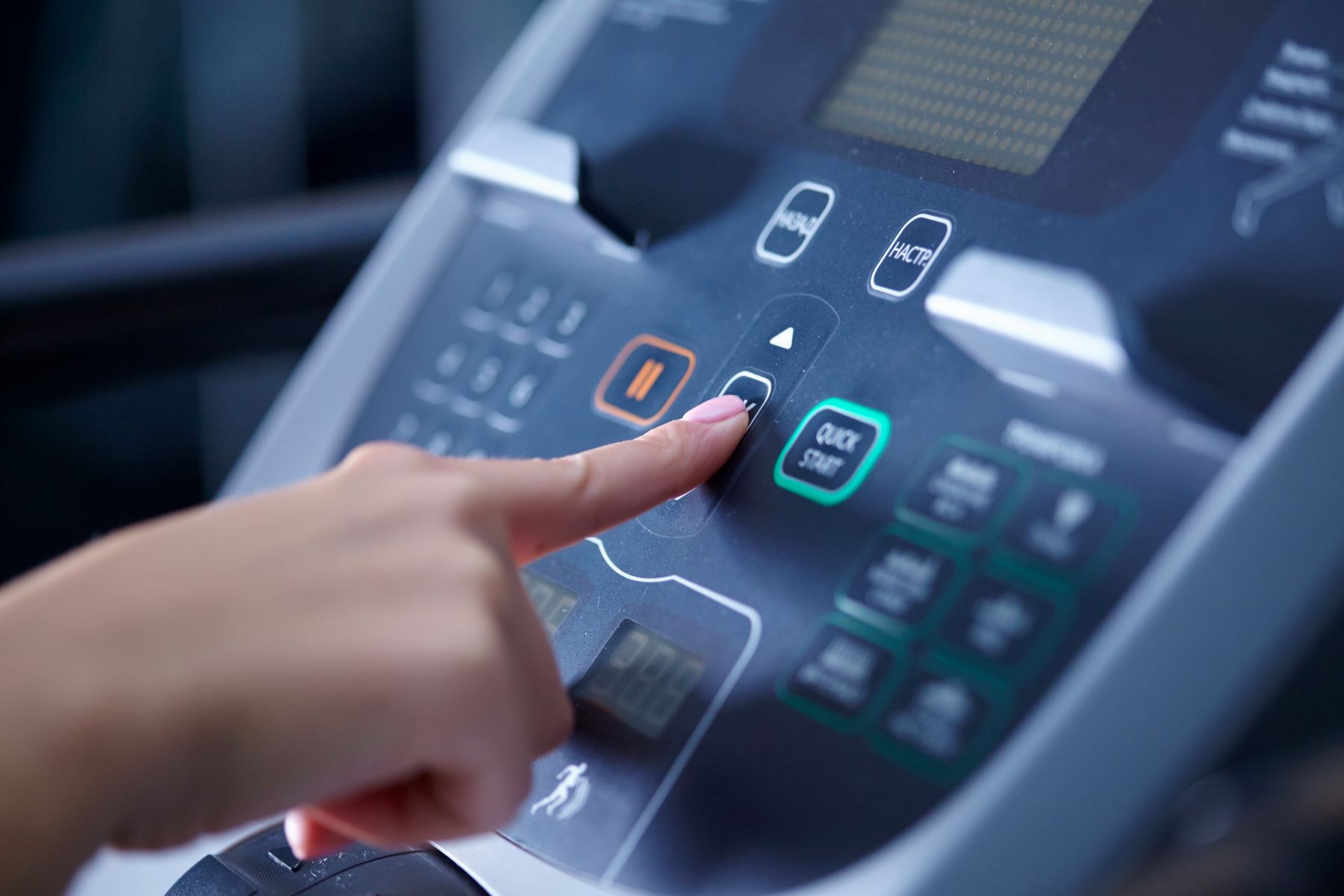

Featured
How To Run Longer On The Treadmill
Modified: August 21, 2023
Discover the best ways to increase your treadmill endurance with our featured guide on how to run longer on the treadmill. Boost your stamina and achieve your fitness goals!
Introduction
Running on the treadmill is a popular form of exercise that offers numerous benefits for both beginners and seasoned runners. Whether you are training for a race, trying to improve your endurance, or simply aiming to burn calories, running longer on the treadmill can help you achieve your fitness goals. However, it can also be a mentally and physically challenging task that requires preparation and determination.
In this article, we will explore various strategies and techniques to help you run longer on the treadmill. From setting realistic goals to maintaining proper form, incorporating interval training, and overcoming mental hurdles, we will cover all aspects that contribute to your success on the treadmill. Additionally, we will provide tips on hydration, nutrition, and injury prevention to ensure a safe and effective workout.
Running on the treadmill offers several advantages over outdoor running. It allows you to control your pace and incline, making it easier to track your progress and tailor your workout to your specific needs. The cushioned surface of a treadmill also reduces the impact on your joints, minimizing the risk of injuries. Furthermore, you can exercise in any weather conditions and have the convenience of staying indoors.
Before diving into the details, it is important to note that running longer on the treadmill requires consistency and patience. It is a gradual process that should be approached with care to avoid overexertion and burnout. By following the guidelines and strategies presented in this article, you will be well-equipped to increase your treadmill running endurance and take your fitness journey to new heights.
Benefits of Running on the Treadmill
Running on the treadmill offers a multitude of benefits that make it a popular choice for many fitness enthusiasts. Whether you are a beginner or an experienced runner, incorporating treadmill workouts into your routine can have a significant impact on your overall fitness levels. Let’s explore some of the key advantages:
- Controlled Environment: One of the biggest advantages of running on a treadmill is the ability to exercise in a controlled environment. You can adjust the speed, incline, and even the duration of your workout with just the touch of a button. This level of control allows you to customize your workout to match your fitness level and goals.
- Joint-Friendly: Treadmills offer a cushioned surface that reduces the impact on your joints compared to running on hard pavement or uneven terrain. This can be particularly beneficial for individuals with joint issues or those who are recovering from injuries. Running on a treadmill can help minimize the risk of joint pain and injuries, allowing for a more comfortable and sustainable running experience.
- Consistent Pace: Maintaining a consistent pace while running is important for building endurance and improving overall cardiovascular fitness. On a treadmill, you can easily set a desired speed and keep it consistent throughout your workout. This enables you to focus on your running form and increase your endurance without worrying about uneven surfaces or external factors.
- Weather Independence: Treadmills provide the convenience of indoor running, allowing you to exercise regardless of the weather conditions outside. Whether it’s scorching hot or pouring rain, you can still get a great workout on a treadmill. This eliminates the need to skip a run due to unfavorable weather and ensures that you can stay dedicated to your fitness routine year-round.
- Accurate Tracking: Treadmills come equipped with built-in tracking features that allow you to monitor important metrics such as distance, speed, calories burned, and heart rate. This data can provide valuable insights into your progress and help you set specific goals for your workouts. By tracking your performance over time, you can easily see improvements and stay motivated on your fitness journey.
These are just a few of the many benefits of running on a treadmill. Whether you are a beginner looking to improve your cardiovascular health or an experienced runner training for a marathon, incorporating treadmill workouts into your routine can help you achieve your fitness goals in a safe and efficient manner.
Preparing for Longer Treadmill Runs
If you aspire to run longer distances on the treadmill, it’s essential to approach your training with the right mindset and preparation. Here are some key tips to help you prepare for longer treadmill runs:
- Gradual Increase: One of the most important aspects of preparing for longer treadmill runs is to gradually increase your distance and duration. Start by adding a few extra minutes to your regular running time and gradually build up from there. Aim to increase your mileage by no more than 10% per week to avoid overuse injuries and allow your body to adapt to the increased demands.
- Strength Training: Incorporating strength training exercises into your workout routine can significantly improve your performance and help prevent injuries. Focus on exercises that target the muscles used while running, such as squats, lunges, and calf raises. Strengthening these muscles will enhance your stability and endurance during longer treadmill runs.
- Warm-up and Cool-down: Prior to each treadmill session, it’s crucial to warm up properly to prepare your muscles for the task ahead. Begin with a few minutes of light cardio, such as brisk walking or jogging. After your run, allow time for a cooldown period to gradually decrease your heart rate. Stretching exercises can be beneficial during this time to relieve muscle tension and promote flexibility.
- Proper Footwear: Investing in a pair of high-quality running shoes is essential for both outdoor and treadmill running. Look for shoes that provide support, cushioning, and a proper fit. Wearing the right footwear will enhance your comfort, reduce the risk of injury, and contribute to a more enjoyable treadmill running experience.
- Appropriate Clothing: Dressing appropriately for your treadmill runs can help you stay comfortable and avoid distractions. Choose moisture-wicking fabrics that allow your skin to breathe and regulate body temperature. Opt for well-fitted clothing that doesn’t restrict your movements. Proper attire will contribute to a more enjoyable and successful treadmill running experience.
By following these guidelines and incorporating them into your training routine, you’ll be well-prepared physically and mentally for longer treadmill runs. Remember to listen to your body, take rest days when needed, and focus on gradual progression to ensure a safe and sustainable increase in your running distance.
Setting Realistic Goals
Setting realistic goals is crucial when it comes to running longer distances on the treadmill. Having clear objectives not only keeps you focused but also helps you stay motivated throughout your training. Here are some tips to help you set realistic goals for your treadmill runs:
- Assess Your Current Fitness Level: Before setting any goals, it’s important to assess your current fitness level. Consider factors such as your running experience, average distance covered, and the pace at which you can comfortably run. This self-assessment will give you a baseline to work from and help you set realistic goals that are aligned with your capabilities.
- Be Specific: Setting specific goals allows you to measure your progress accurately. Instead of simply aiming to “run longer,” set a specific distance or time goal. For example, you may aim to increase your treadmill run from 3 miles to 5 miles or to run continuously for a set duration, such as 45 minutes.
- Consider Timelines: Determine a timeline for achieving your goals. Be realistic about the time it will take to increase your running distance. Setting a deadline can help you stay accountable and motivated throughout your training. However, avoid being too rigid with your timeline and allow for flexibility as your body adapts to the increased demands.
- Break It Down: Breaking your larger goal into smaller milestones can make it more manageable and achievable. For example, if your ultimate goal is to run 10 miles on the treadmill, break it down into smaller milestones of increasing your distance by 1 mile at a time. Celebrating these smaller victories along the way will keep you motivated and focused on your progress.
- Listen to Your Body: It’s important to listen to your body and adjust your goals accordingly. If you experience discomfort or pain during your training, it’s a sign that you may need to slow down or take a rest day. Pushing through injuries can lead to long-term damage and hinder your progress. Remember, it’s better to take a step back temporarily to avoid setbacks in the long run.
By setting realistic and specific goals, considering timelines, breaking them down into smaller milestones, and listening to your body, you’ll be able to track your progress and gradually increase your running distance on the treadmill. Remember that progress is individual, and comparing yourself to others may not be productive. Stay focused on your own journey and celebrate the milestones you achieve along the way.
Maintaining Proper Form
Maintaining proper form is essential for efficient and injury-free running, whether on the treadmill or outdoors. Proper form not only optimizes your performance but also minimizes the risk of strain or overuse injuries. Here are some key tips to help you maintain proper form during your treadmill runs:
- Posture: Keep your posture upright while running on the treadmill. Avoid slouching or leaning too far forward or backward. Engage your core muscles to support your spine and maintain a tall and relaxed posture throughout your run.
- Foot Placement: Land softly on your midfoot or forefoot with each stride. Avoid striking the ground with your heel as this puts unnecessary stress on your joints. Keep a quick and light foot turnover to minimize the impact on your lower body.
- Arm Swing: Keep your arms relaxed and bent at a 90-degree angle. Avoid crossing them over your body or allowing them to swing too wide. Your arms should move in a back-and-forth motion, in coordination with your legs, to help maintain balance and propel you forward.
- Cadence: Aim for a cadence, or step rate, of around 160-180 steps per minute. A higher cadence promotes shorter, quicker strides, which can reduce the strain on your joints and improve your running efficiency. Focus on increasing your cadence gradually without sacrificing proper form.
- Head Position: Keep your head in a neutral position, looking straight ahead. Avoid staring at the treadmill display or looking down at your feet, as this can affect your posture and put strain on your neck and upper body. Keeping your gaze forward helps maintain proper alignment and running form.
- Breathing: Pay attention to your breathing while running. Breathe deeply and rhythmically, inhaling through your nose and exhaling through your mouth. Focus on taking full breaths to oxygenate your muscles and maintain a steady rhythm that aligns with your running pace.
Practicing and maintaining proper form may require conscious effort initially, but with time and consistency, it will become second nature. Regularly check in with your body and make necessary adjustments to ensure you’re running with optimal form. Consider recording yourself to visually analyze your form or seek guidance from a running coach if needed.
Remember, maintaining proper form not only improves your running efficiency and performance but also minimizes the risk of injuries. By paying attention to your posture, foot placement, arm swing, cadence, head position, and breathing, you’ll be able to run longer distances on the treadmill while minimizing the strain on your body.
Breathing Techniques for Long Runs
Proper breathing techniques are crucial for maintaining endurance and optimizing performance during long runs on the treadmill. By adopting efficient breathing patterns, you can increase oxygen intake, reduce fatigue, and improve your overall running experience. Here are some effective breathing techniques to implement during your long treadmill runs:
- Deep Belly Breaths: Focus on taking deep breaths from your diaphragm rather than shallow chest breaths. This type of breathing, also known as belly or diaphragmatic breathing, allows for maximum oxygen intake and helps maintain a relaxed and efficient running posture.
- Inhale through the Nose, Exhale through the Mouth: Inhaling through your nose helps filter and warm the air before it reaches your lungs. It also promotes a slower, more controlled intake of breath. Exhaling through your mouth allows for the release of carbon dioxide more efficiently. This breathing pattern can help maintain a steady pace and avoid breathlessness during long runs.
- Rhythmic Breathing: Adopting a rhythmic breathing pattern can help synchronize your breath with your stride and maintain a steady and efficient rhythm. Many runners find a 2:2 or 3:3 pattern effective, inhaling for two or three steps and exhaling for the same number of steps. Experiment with different patterns to find what works best for you.
- Focus on Exhalation: During your long treadmill runs, pay particular attention to your exhalation. Fully exhaling can help rid your body of stale air and carbon dioxide, making room for a deeper inhalation. Emphasize a strong and complete exhalation, ensuring that you are fully expelling air from your lungs before taking the next breath.
- Relaxation and Mindfulness: Incorporate relaxation and mindfulness techniques into your breathing during long treadmill runs. Stay focused on your breath, using it as a cue to stay present and in tune with your body. Avoid tensing up or holding your breath during difficult moments. Instead, consciously relax your muscles and maintain a steady, controlled breath.
Remember, breathing techniques require practice and may take time to become comfortable with. During your training, incorporate specific breathing exercises to reinforce proper technique. This could include dedicated breathing drills or incorporating focused breathing techniques into shorter treadmill runs before gradually incorporating them into longer sessions.
By integrating these breathing techniques into your long treadmill runs, you can enhance your endurance, reduce fatigue, and optimize your overall running performance. Consistent practice will allow your body to adapt, making proper breathing a natural and effortless part of your running routine.
Incorporating Interval Training
Interval training is a highly effective method to improve cardiovascular fitness, increase endurance, and enhance overall treadmill running performance. By alternating between periods of high-intensity effort and active recovery, interval training pushes your limits, helps you burn more calories, and takes your treadmill runs to the next level. Here’s how you can incorporate interval training into your routine:
- Warm-Up: Begin your treadmill session with a 5-10 minute warm-up, engaging in light cardio such as brisk walking or slow jogging. This prepares your body for the intense intervals to come and helps prevent injuries.
- Interval Structure: Choose a work-to-rest ratio that aligns with your current fitness level and goals. For example, you may start with a 1:1 ratio, where you perform a high-intensity effort for 1 minute, followed by 1 minute of active recovery. As you progress, you can increase the work period and decrease the rest period.
- High-Intensity Efforts: During the work periods, increase your speed or incline to a challenging level that pushes your limits. Go all out and maintain a pace that makes it challenging to hold a conversation. This intensity will help improve your speed, endurance, and cardiovascular capacity.
- Active Recovery: During the rest periods, lower your intensity to a comfortable pace, allowing your heart rate to recover. This active recovery phase should be less challenging, giving your body a chance to regain some energy before the next high-intensity effort.
- Repeat and Progress: Repeat the intervals for a desired number of sets or a specific timeframe. As you become more comfortable with interval training, gradually increase the intensity or duration of the high-intensity efforts, shorten the rest periods, or add more sets.
- Cool-Down: After completing your interval training, cool down by gradually reducing your speed and incline. Spend 5-10 minutes walking or jogging at an easy pace to allow your heart rate to return to normal and prevent muscle soreness.
Incorporating interval training into your treadmill runs not only adds variety to your workouts but also challenges your body in different ways. It improves anaerobic and aerobic fitness, increases your lactate threshold, and boosts calorie burn even after your workout.
Remember, interval training can be intense, so it’s important to listen to your body and progress at a pace that is suitable for you. If you’re new to interval training, start with shorter intervals and longer rest periods, then gradually increase the intensity and decrease the rest time as your fitness improves.
By adding interval training to your treadmill routine, you’ll see significant improvements in your running performance, endurance, and overall cardiovascular fitness. It’s an effective and time-efficient way to challenge yourself and take your treadmill runs to new heights.
Mental Strategies for Running Longer
Running longer distances on the treadmill requires not only physical endurance but also mental fortitude. Building mental strength and resilience is key to overcoming the challenges and pushing through mental barriers. Here are some effective mental strategies to help you run longer on the treadmill:
- Set Positive Intentions: Start your treadmill run with a positive mindset. Set intentions for your workout, such as focusing on gratitude, embracing the challenge, or simply enjoying the process. Setting positive intentions helps shift your mindset and keeps you motivated throughout your run.
- Break it Down: Instead of focusing on the entire distance or time, break your run into smaller segments or milestones. Concentrate on reaching each milestone and celebrate your progress along the way. This approach makes the distance feel more manageable and helps prevent mental fatigue or overwhelm.
- Visualize Success: Use the power of visualization to imagine yourself successfully completing your run. Visualize the feeling of accomplishment, the sights and sounds around you, and the satisfaction of reaching your goal. This mental imagery can significantly boost your motivation and help you stay focused during challenging moments.
- Positive Self-Talk: Pay attention to your internal dialogue and replace any negative thoughts or self-doubt with positive affirmations. Remind yourself of your capabilities, strength, and determination. Encourage yourself with words like, “I can do this,” “I am strong,” and “I am making progress.” Positive self-talk can help boost your confidence and keep you motivated throughout your run.
- Utilize Distraction Techniques: Distraction can be a powerful tool to combat mental fatigue and boredom during longer treadmill runs. Listen to music, audiobooks, podcasts, or watch TV shows or movies to keep your mind engaged. Alternatively, focus on your breath, count your steps, or observe your surroundings to divert your attention away from the effort of running.
- Practice Mindfulness: Bring mindfulness into your treadmill runs by paying attention to your breath, body sensations, and the present moment. Stay fully present in each stride and embrace the experience without judgment. Mindfulness can help you cultivate a sense of calm, reduce stress, and make your run more enjoyable and mentally fulfilling.
Remember, building mental strength takes time and practice. Be patient with yourself and acknowledge that running longer distances on the treadmill can be mentally challenging. Experiment with different strategies and find what works best for you. Mix and match these techniques to keep your mindset fresh and motivated during your runs.
By incorporating these mental strategies into your treadmill running routine, you’ll develop mental resilience, overcome mental barriers, and be better equipped to run longer distances. Remember that your mind is just as important as your body when it comes to achieving your running goals.
Hydration and Nutrition Tips
Proper hydration and nutrition are crucial for optimizing performance, maintaining energy levels, and preventing dehydration during longer treadmill runs. Implementing the following tips will help you stay fueled and hydrated throughout your workouts:
- Hydration: Drink water before, during, and after your treadmill runs to maintain optimal hydration. Aim to consume at least 8 ounces of water 30 minutes before your run, and rehydrate with regular sips of water during your workout. Listen to your body’s thirst cues and adjust your water intake accordingly. If you’re running longer distances, consider incorporating electrolyte-rich sports drinks to replenish lost electrolytes.
- Pre-Run Nutrition: Consuming a balanced meal or snack before your treadmill run is essential for providing the energy your body needs. Opt for a combination of carbohydrates, such as whole grains or fruits, and protein for sustained energy. Experiment with different pre-run meals to find what works best for your body and gives you the necessary fuel to run longer distances comfortably.
- During-Run Fuel: If you plan to run for longer than an hour, you may need to replenish your energy stores during your run. Consider using energy gels, sports chews, or electrolyte tablets to sustain your energy levels. Experiment with different options during your training to find what works best for your body and doesn’t cause discomfort or gastrointestinal issues.
- Post-Run Recovery: After your treadmill run, prioritize post-run recovery by consuming a balanced meal or snack within 30 minutes. This meal should include carbohydrates to replenish glycogen stores, protein for muscle repair, and fluids to rehydrate. Fueling properly after your run supports recovery, reduces muscle soreness, and prepares your body for future workouts.
- Listen to Your Body: Every individual is unique, and what works for one person may not work for another. Pay attention to your body’s signals and adjust your hydration and nutrition strategies accordingly. Experiment with different fluids, foods, and timing to find what keeps you adequately hydrated and energized during your treadmill runs.
- Preventive Measures: Minimize the risk of dehydration by ensuring the room is well-ventilated and maintaining a cool environment while running on the treadmill. Consider using a fan or adjusting the temperature in the room to prevent excessive sweating and fluid loss. Additionally, always have a water bottle nearby for convenient access to hydration.
Remember to consult with a healthcare professional or registered dietitian for personalized hydration and nutrition guidance, especially if you have specific dietary needs or health conditions.
By incorporating proper hydration and nutrition practices into your routine, you’ll fuel your body for longer treadmill runs, maintain energy levels, and optimize your performance. Stay mindful of your body’s needs and make adjustments as necessary to ensure a safe and successful running experience.
Overcoming Boredom on the Treadmill
Running on the treadmill can sometimes feel repetitive and monotonous, leading to boredom during your workouts. However, there are several strategies you can implement to overcome this boredom and keep yourself motivated and engaged while running on the treadmill:
- Vary Your Workout: Incorporate different workout formats and variations to keep things interesting. Explore intervals, hills, or incline training. Challenge yourself with speed workouts or progressive runs. Mixing up your workout routine not only prevents boredom but also helps improve your fitness levels and keeps you mentally engaged.
- Listen to Music or Podcasts: Create a carefully curated playlist of motivational and energizing songs that resonate with you. Music can boost your mood, distract you from the monotony of the treadmill, and enhance your overall running experience. Alternatively, listen to podcasts or audiobooks to engage your mind and make the time fly by.
- Watch TV Shows or Movies: Set up a tablet or TV in front of the treadmill and watch your favorite TV shows or movies while running. This can provide an entertaining distraction and make your treadmill workouts feel less tedious. Just make sure to secure the device properly and maintain proper posture and form while running.
- Engage with Virtual Running Apps or Videos: Explore virtual running apps or videos that simulate outdoor running experiences. These apps often feature scenic routes and provide a more immersive and engaging experience. They can help alleviate boredom by creating the sensation of running outside while you’re on the treadmill.
- Practice Mindfulness: Instead of viewing the treadmill as a chore, shift your mindset and practice mindfulness during your runs. Focus on your body, breath, and the feeling of each stride. Engage all your senses and be fully present in the moment. Mindfulness can help you find joy in the act of running and make it a more enjoyable experience.
- Create Challenges or Goals: Set specific challenges or goals for yourself during your treadmill runs. This could include reaching a certain distance or duration, improving your speed, or conquering new incline levels. Having a target to work towards gives you something to focus on and can help alleviate boredom by providing a sense of purpose and accomplishment.
- Run with Virtual or Real-Life Running Buddies: Connect with running communities or find virtual running buddies through apps or online platforms. Running with others virtually or even just knowing that others are running at the same time can provide a sense of camaraderie and motivation. Share your progress, set challenges together, and engage in friendly competition to keep the excitement alive.
Remember that overcoming boredom on the treadmill is a mindset and requires a deliberate effort to keep things engaging. Mix and match these strategies, and experiment to find what works best for you. Be creative, open-minded, and stay motivated as you explore different ways to make your treadmill runs more enjoyable and fulfilling.
Recovery and Injury Prevention
Recovery and injury prevention are essential aspects of any fitness routine, including running on the treadmill. Taking the necessary steps to recover properly and prevent injuries will ensure that you can continue running longer distances without setbacks. Here are some important practices to incorporate into your routine:
- Rest and Recovery Days: Schedule regular rest days in your running routine to allow your body to recover and repair. Rest days are just as important as workout days as they give your muscles and joints time to heal and rebuild. Incorporate other low-impact activities or active recovery exercises, such as yoga or swimming, to promote blood flow and reduce muscle soreness.
- Proper Sleep: Make sure you’re getting enough quality sleep to support your body’s recovery process. Sleep is when your body repairs tissues, balances hormones, and rejuvenates. Aim for 7-9 hours of uninterrupted sleep each night to optimize your recovery and overall performance.
- Stretching and Flexibility: Incorporate stretching exercises into your cool-down routine after each treadmill run. Stretching helps improve flexibility, increases range of motion, and prevents muscle imbalances. Focus on major muscle groups used in running, such as your calves, quadriceps, hamstrings, and hip flexors. Consider adding activities like yoga or Pilates to enhance your overall flexibility and balance.
- Strength and Cross-Training: Include strength training exercises in your weekly routine to strengthen muscles, improve stability, and reduce the risk of injuries. Focus on exercises that target your lower body and core, such as squats, lunges, hip thrusts, and planks. Additionally, cross-training activities like cycling or swimming can help prevent overuse injuries and provide variety to your workouts.
- Listen to Your Body: Pay attention to any signs of pain or discomfort during your treadmill runs. Pushing through pain can lead to more severe injuries. If you experience persistent pain, swelling, or discomfort, seek medical advice to prevent further damage. It’s important to listen to your body’s signals and modify your workouts or take necessary rest days when needed.
- Proper Nutrition: Fueling your body with the right nutrients is crucial for recovery and injury prevention. Consume a well-balanced diet that includes an adequate amount of carbohydrates, protein, healthy fats, and micronutrients. Prioritize whole, nutrient-dense foods to support your body’s repair processes and enhance overall performance. Consult a registered dietitian to address your specific nutritional needs.
- Proper Gear and Footwear: Wear appropriate running shoes that provide proper support and cushioning for your feet. Replace your shoes regularly, as worn-out shoes can increase the risk of injuries. Additionally, consider wearing moisture-wicking, comfortable clothing to prevent chafing and minimize friction during your runs.
By prioritizing recovery and injury prevention, you’ll be able to sustain your running routine and continue progressing on the treadmill. Remember, it’s better to take proactive measures to prevent injuries than to deal with the consequences of overexertion or neglecting recovery. Listen to your body, adjust your training when necessary, and prioritize your overall well-being.
Conclusion
Congratulations! You’ve now learned various strategies and techniques to help you run longer on the treadmill. By implementing these tips, you can enhance your endurance, improve your performance, and achieve your fitness goals. Remember, running longer distances on the treadmill requires both physical and mental preparation. Start by setting realistic goals, gradually increasing your mileage, and maintaining proper form throughout your runs.
Engage in interval training to challenge yourself and improve your overall cardiovascular fitness. Implementing proper hydration and nutrition strategies will ensure you have the energy and endurance to tackle those longer runs. And when boredom starts to creep in, utilize various techniques such as varying your workout, listening to music or podcasts, and engaging in mindful running practices to keep your motivation high.
Recovery and injury prevention are crucial aspects of running longer on the treadmill. Prioritize rest days, proper sleep, stretching, and strength training to allow your body to recover and reduce the risk of injuries. Listen to your body, be mindful of any pain or discomfort, and seek professional advice if needed.
Remember, every treadmill run is an opportunity for growth, both physically and mentally. Embrace the challenge, be patient with yourself, and celebrate your progress along the way. Running longer distances on the treadmill is a journey that requires dedication and perseverance, but with the right strategies and mindset, you can reach new milestones and achieve your running goals.
So, lace up your running shoes, step onto the treadmill, and embark on an incredible journey of improved endurance, increased fitness, and personal triumph. Get ready to see just how far you can go!
